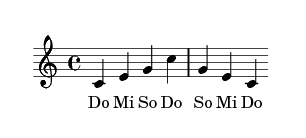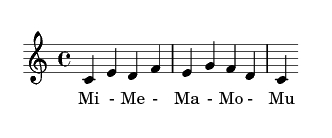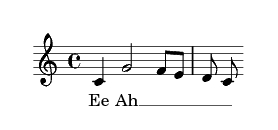If you’re about to take over the leadership of an established choir here are some ideas on how you should prepare for your first day on the job and some easy, effective warm-ups you can get started with. This should be especially useful if you haven’t had any prior experience conducting a choir.
What’s a good goal for the first choir rehearsal?
If you’ve never led a choir before don’t be surprised if you discover that there’s a lot more to directing than just giving starting pitches and telling the choir to start singing. Sadly, I learned that the hard way. Prior to my first rehearsal I’d spent a fair amount of time thinking about how to structure rehearsals, what songs to sing, and how to go about teaching sight-singing, but I hadn’t put much thought into basic things like leading warm-ups or how I’d actually go about keeping time. Also I had a small problem with playing through voice parts, and ended up stumbling through them on the piano. What better way to inspire confidence than to play 8th notes like quarter notes or play the bass line in treble clef? I know few other ways. -_- Needless to say my first rehearsal was fairly close to a disaster. But I got through it, and my choir has been, thankfully, very forgiving.
While my intentions were good, I think I’d have done better to spend more time learning how to conduct and pushed my sight-singing research to later. I didn’t start employing formal conducting techniques until 5 months after I began directing, and I’m kicking myself now. When I finally got around to using them I found that the choir sang much closer to the tempo I was intending and came in at the right time verse after verse. It was such an improvement.
Another good reason to spend time learning how to conduct from the start is that there’s no getting away from conducting. At just about every rehearsal the choir will be singing through songs or parts of songs and the main job of the director is to conduct those songs. You may as well learn how to do it at the start because if you want your choir to be any good you’ll have to find an effective conducting system at some point.
So, I’d say a good overall goal for the first rehearsal would be to conduct songs with a measurable amount of confidence and competence. This will leave choir members feeling confident that they’ve left their choir in the hands of someone who can handle the basics, which is important. A future article will go into the mechanics of and justification for conducting, but for now here’s a pretty good book on the subject. Conducting Made Easy
What about Warm-ups?
If you’re going to do unison chromatic style warm-ups (i.e. everyone sings the exercises together and each successive warm-up travels either up or down the keyboard by one half-step), I have some advice. First, it’s better not to play than to play wrong notes. If you don’t want to play every warm-up in every key, don’t. Just play the first few and then play the starting note. After a one or two repetitions the choir will get the hang of it and can sing the rest of the notes without the piano. Later on you can test if they’re still on pitch with some easier keys. This is especially useful toward the higher and lower ends of the vocal range since at the top people tend to go flat and at the bottom people tend to go sharp.
To get started, play the exercise on the piano once, sing it once with confidence, and play it again for the choir to sing with. For warm-ups it doesn’t hurt for the choir director to sing too. It’s also a good idea to practice them at home first since many of them sound silly and it may take some time before you feel comfortable leading them without laughing.
When doing exercise that move up, I start on the G below middle C and keep going until the notes start becoming uncomfortable. When moving down, I start on middle C and keep going until no sound comes out.
If you don’t have any idea which warm-ups to start with here are three to get you going.
Up-moving


Down-moving

In future articles I’ll discuss warm-ups and vocalizes, but for now these will do.
If you’re against doing unison warm-ups or don’t have time to practice them before the first rehearsal, you can always sing some easy mid-range songs. The rule of thumb here is not to start with songs that the sopranos or basses complain about. If you don’t know what a comfortable range is, ask your choir members which notes are uncomfortable for them to sing or which songs are comfortable or uncomfortable to sing. That should give you an idea.
How well should I know the parts?
If you’re going to spend a significant amount of time on any one song you should know how to play the parts for the song on the piano. You may get called on to play it for them and it’s kind of embarrassing to stumble through it. Also, when the choir is singing you’ll want to diagnose which sections are strong or weak. If you don’t know what the altos are supposed to be singing you’ll have no way of knowing if they’re singing the right thing. While, you’re going to want to do this sooner rather than later I’d say it’s less important than conducting because you can go through an entire rehearsal without giving parts. The same can’t be said about conducting.
How do I give pitches?
I know it sounds pretty basic, but there are some things to remember even with this. Try to figure out the tempo before you give pitches. If you give pitches first the chances are much greater that people will lose their note once you’ve figured out the tempo. Pick a direction to give pitches (bass to sop or sop to bass) and stick with it. Don’t go too slow or too fast. To figure out what too slow or too fast is try going faster than you think you should. If they complain give them again a little slower until you find a good speed. Some people like to hear the starting chord and if you go too slow it’s much harder to do.
Should I sing while I’m directing?
At the first rehearsal probably not. It’s hard enough to conduct and listen at the same time. Adding singing on the top of that only makes the process more difficult. This doesn’t mean directors should never sing, though.
So, for your first rehearsal you should really concentrate on the basics of choir directing, which is to say conducting. The techniques are just as useful for a barbershop quartet as they are for a church choir, and if you want to be an effective director you’ll have to come up with some method eventually so you might as well do it from day one. Once you’re mostly confident with conducting, you should find some sort of warm-up routine so that your sopranos can comfortably hit the high-notes later on. After that you should probably start learning all of the parts for the songs you’ll be practicing. That’s another one of those things you’re going to need to do anyway, but it’s not quite as critical as conducting so if you can only work on either conducting or parts for the first rehearsal you should work on conducting.







